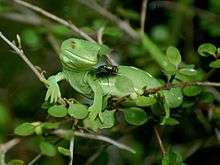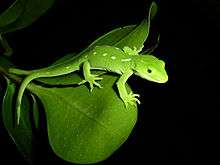Wellington green gecko
The Wellington green gecko (Naultinus punctatus) is a species of gecko found only in the southern half of the North Island of New Zealand. It was previously considered a subspecies of the Auckland green gecko, and together called the common green gecko.
| Wellington green gecko | |
|---|---|
 | |
| Scientific classification | |
| Kingdom: | Animalia |
| Phylum: | Chordata |
| Class: | Reptilia |
| Order: | Squamata |
| Family: | Diplodactylidae |
| Genus: | Naultinus |
| Species: | N. punctatus |
| Binomial name | |
| Naultinus punctatus Gray, 1843 | |
| Synonyms | |
| |
The Wellington green gecko is much larger and more heavily built than the Auckland green gecko and can be distinguished by the yellow soles on its feet instead of grey-green. It lives arboreally in scrub and forest areas, especially kanuka and manuka. Although it hunts nocturnally, for moths and flies, it also likes to sun-bask. It displays an aggressive behaviour, baring its open blue mouth and barking if provoked.
Conservation status
In 2012 the Department of Conservation classified the Wellington green gecko as At Risk under the New Zealand Threat Classification System. It was judged as meeting the criteria for At Risk threat status as a result of it having a low to high ongoing or predicted decline. This gecko is also regarded as being Data Poor.[1]
Conservation efforts

The Department of Conservation has translocated Wellington green geckos to several locations.[2] From 1997 to 2001 22 Wellington green geckos (8 males, 4 females, 10 unknown) were translocated to Mana Island. The geckos appear to be established on Mana Island.[3] Between 2006 and 2013 over 90 Wellington green geckos were released on Matiu / Somes Island. All were photographed and their unique markings recorded. Early in 2015 a young female gecko was discovered that had markings that did not match any of those recorded. This indicated that a breeding population had been established on the island.[4]
References
- Hitchmough, Rod; Anderson, Peter; Barr, Ben; Monks, Jo; Lettink, Marieke; Reardon, James; Tocher, Mandy; Whitaker, Tony. "Conservation status of New Zealand reptiles, 2012" (PDF). Department of Conservation. The Government of New Zealand. Retrieved 18 July 2015.
- Lizard action plan for Poneke Area, Wellington Conservancy 2009–2014 (PDF). Wellington: Department of Conservation. 2009. ISBN 9780478146004. Retrieved 27 July 2015.
- "Naultinus elegans punctatus Barking gecko, Wellington green gecko". Landcare Research NZ Lizard Database. Landcare Research. Retrieved 27 July 2015.
- "Photo of the week: Wellington green gecko". Conservation blog. Department of Conservation. Retrieved 27 July 2015.
External links
| Wikispecies has information related to Naultinus elegans punctatus |
